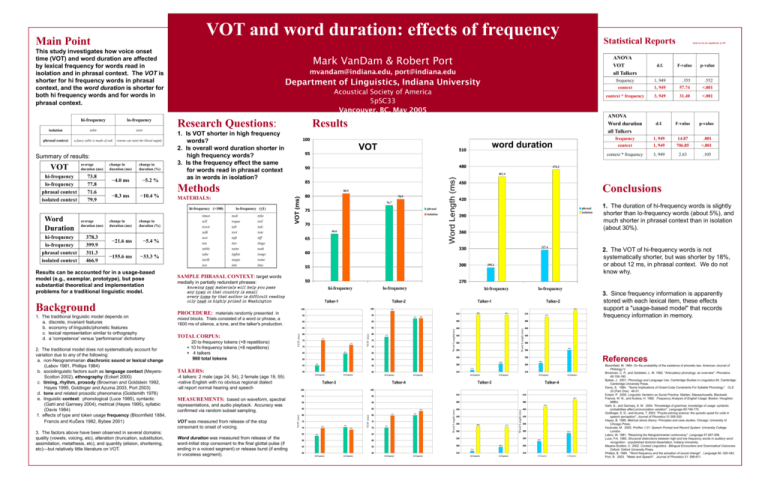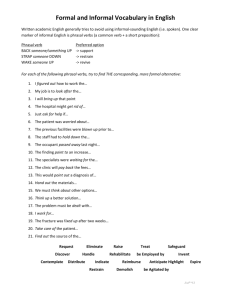PPT - VanDamMark.com
advertisement

VOT and word duration: effects of frequency Main Point This study investigates how voice onset time (VOT) and word duration are affected by lexical frequency for words read in isolation and in phrasal context. The VOT is shorter for hi frequency words in phrasal context, and the word duration is shorter for both hi frequency words and for words in phrasal context. hi-frequency lo-frequency phrasal context isolated context 73.8 77.8 71.6 79.9 change in duration (ms) −4.0 ms −8.3 ms change in duration (%) −5.2 % −10.4 % average duration (ms) hi-frequency lo-frequency phrasal context isolated context 378.3 399.9 311.3 466.9 change in duration (ms) −21.6 ms −155.6 ms change in duration (%) −5.4 % −33.3 % Results can be accounted for in a usage-based model (e.g., exemplar, prototype), but pose substantial theoretical and implementation problems for a traditional linguistic model. Background 1. The traditional linguistic model depends on a. discrete, invariant features b. economy of linguistic/phonetic features c. lexical representation similar to orthography d. a 'competence' versus 'performance' dichotomy 2. The traditional model does not systematically account for variation due to any of the following: a. non-Neogrammarian diachronic sound or lexical change (Labov 1981, Phillips 1984) b. sociolinguistic factors such as language contact (MeyersScotton 2002), ethnography (Eckert 2000) c. timing, rhythm, prosody (Browman and Goldstein 1992, Hayes 1995, Goldinger and Azuma 2003, Port 2003) d. tone and related prosodic phenomena (Goldsmith 1976) e. linguistic context: phonological (Luce 1985), syntactic (Gahl and Garnsey 2004), metrical (Hayes 1995), syllabic (Davis 1984) f. effects of type and token usage frequency (Bloomfield 1884, Francis and Kučera 1982, Bybee 2001) 3. The factors above have been observed in several domains: quality (vowels, voicing, etc), alteration (truncation, substitution, assimilation, metathesis, etc), and quantity (elision, shortening, etc)—but relatively little literature on VOT. 480 lo-frequency (≤1) tusk toque tab tort tuft tier taint tights taupe tint tyke toil talc tote tiff tinge teak tongs tome tine 85 80 78.9 76.7 75 phrasal isolation 70 66.6 65 medially in partially redundant phrases: phrasal isolation 360 270 327.4 1, 949 .355 .552 context 1, 949 57.74 <.001 context * frequency 3, 949 31.40 <.001 ANOVA Word duration all Talkers d.f. F-value p-value frequency context 1, 949 1, 949 14.87 706.85 .001 <.001 context * frequency 3, 949 2.63 .105 p-value lo-frequency hi-frequency Talker-2 lo-frequency Talker-1 Talker-2 100 100 95 95 90 90 480 480 85 85 450 450 80 80 524.4 98.3 510 92.3 75.3 75 71.5 70 65 64.5 510 505.7 55 77.8 75 70 420 390 360 330 60 TALKERS: 54.9 497.3 92.6 65 60 506.8 390 360.4 360 References 306.3 300 277.9 50 50 hi-frequency -4 talkers: 2 male (age 24, 54), 2 female (age 19, 55) -native English with no obvious regional dialect -all report normal hearing and speech lo-frequency 270 hi-frequency Talker-3 MEASUREMENTS: based on waveform, spectral lo-frequency 270 hi-frequency Talker-4 100 100 95 95 lo-frequency hi-frequency lo-frequency Talker-4 Talker-3 510 510 489.7 90 representations, and audio playback. Accuracy was confirmed via random subset sampling. 480 480 90 461.0 85 85 80 80 75 69.7 70 65 70.5 68.5 83.2 79.7 79.8 75 70 70.1 65 63.5 60 60 55 55 450 420 390 380.4 377.5 360 450 420 390 360 330 330 300 295.3 351.0 318.5 300 278.1 50 50 hi-frequency lo-frequency 270 270 hi-frequency lo-frequency hi-frequency lo-frequency 3. Since frequency information is apparently stored with each lexical item, these effects support a "usage-based model" that records frequency information in memory. 420 330 300 55 1. The duration of hi-frequency words is slightly shorter than lo-frequency words (about 5%), and much shorter in phrasal context than in isolation (about 30%). 2. The VOT of hi-frequency words is not systematically shorter, but was shorter by 18%, or about 12 ms, in phrasal context. We do not know why. 295.2 303.8 Word duration was measured from release of the word-initial stop consonant to the final glottal pulse (if ending in a voiced segment) or release burst (if ending in voiceless segment). frequency F-value Conclusions 390 50 Talker-1 mixed blocks. Trials consisted of a word or phrase, a 1600 ms of silence, a tone, and the talker's production. VOT was measured from release of the stop consonant to onset of voicing. d.f. 420 300 hi-frequency PROCEDURE: materials randomly presented in 450 55 knowing test materials will help you pass any town in that country is small every tome by that author is difficult reading oily teak is highly prized in Washington 20 lo-frequency tokens (×8 repetitions) + 10 hi-frequency tokens (×8 repetitions) × 4 talkers 960 total tokens ANOVA VOT all Talkers 474.2 330 60 SAMPLE PHRASAL CONTEXT: target words TOTAL CORPUS: items in red are significant, p<.05 461.4 80.9 MATERIALS: times tell town talk test ten table take teeth too 510 90 Methods hi-frequency (>100) Word Duration 95 word duration Word Length (ms) VOT average duration (ms) VOT Word Length (ms) Summary of results: 100 Word Length (ms) venom can taint the blood supply 1. Is VOT shorter in high frequency words? 2. Is overall word duration shorter in high frequency words? 3. Is the frequency effect the same for words read in phrasal context as in words in isolation? Word Length(ms) a fancy table is made of oak Results Word Length (ms) phrasal context Research Questions: VOT (ms) taint Acoustical Society of America 5pSC33 Vancouver, BC, May 2005 VOT (ms) table Department of Linguistics, Indiana University VOT (ms) isolation mvandam@indiana.edu, port@indiana.edu VOT (ms) lo-frequency Mark VanDam & Robert Port VOT (ms) hi-frequency Statistical Reports hi-frequency lo-frequency Bloomfield, M. 1884. On the probability of the existence of phonetic law. American Journal of Philology V. Browman, C. P., and Goldstein, L. M. 1992. "Articulatory phonology: an overview". Phonetica 49:159-180. Bybee, J. 2001. Phonology and Language Use. Cambridge Studies in Linguistics 94. Cambridge: Cambridge University Press. Davis, S. 1984. "Some Implications of Onset-Coda Constraints For Syllable Phonology." CLS 20 (Part One): 46-51. Eckert, P. 2000. Linguistic Variation as Social Practice. Malden, Massachusetts: Blackwell. Francis, W. N., and Kučera, H. 1982. Frequency Analysis of English Usage. Boston: Houghton Mifflin. Gahl, S., and Garnsey, S. M. 2004. "Knowledge of grammar, knowledge of usage: syntactic probabilities affect pronunciation variation". Language 80:748-775. Goldinger, S. D., and Azuma, T. 2003. "Puzzle-solving science: the quixotic quest for units in speech perception". Journal of Phonetics 31:305-320. Hayes, B. 1995. Metrical stress theory: Principles and case studies. Chicago: University of Chicago Press. Huckvale, M. 2005. ProRec 1.01: Speech Prompt and Record System: University College London. Labov, W. 1981. "Resolving the Neogrammarian controversy". Language 57:267-308. Luce, P.A. 1985. Structural distinctions between high and low frequency words in auditory word recognition. unpublished doctoral dissertation, Indiana University. Meyers-Scotton, C. 2002. Contact Linguistics: Bilingual Encounters and Grammatical Outcomes. Oxford: Oxford University Press. Phillips, B. 1984. "Word frequency and the actuation of sound change". Language 60: 320-342. Port, R. 2003. "Meter and Speech". Journal of Phonetics 31: 599-611.








